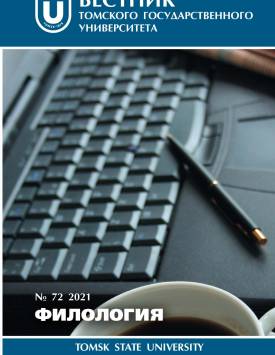A German as a Character of the Way (Based on Anton Chekhov’s Novella The Duel)
The article deals with the image of the character von Koren in Anton Chekhov’s novella The Duel in connection with German types of characters in Russian literature of the 19th century. Along with Chekhov’s novella, other Russian writers’ works related with the literary Germanness are used in order to determine common and differential features of German characters in the analyzed texts. These are Osip Senkovsky’s story “The Scientific Journey to Bear Island”, Kozma Prutkov’s operetta “Chereposlov, videlicet Phrenologist”, Nikolai Leskov’s story “Iron Will”, Ivan Goncharov’s novel Oblomov, and some others. The main methods of the study are structural semiotics and comparative-typological analysis. The theoretical basis of the article builds on Yu.M. Lotman’s typology of characters whereby the characters of the way, the place and the ‘steppe’ are distinguished and German character types in Russian literature of the 19th century (A.V. Zhukovskaya et al.) are classified. In the context of appealing to literary character types of other nations, The Duel could be attributed to the ‘transitional’ period of Chekhov’s work. Opposite to the early texts of the author where ethnic stereotypes are used as is to create a comic effect, the later texts are characterized with the shift away from the simple ‘copying’ of character types. In this respect, von Koren’s image is notable for its greater individualization and ambivalence. On the one hand, this image has features similar to characteristics of such German character types in Russian literature as German scientists and even ‘good Germans’ (‘dobrye nemtsy’), namely, philistines. Irrational fidelity to a theory or a plan, straightforwardness and intention to regularize the surrounding space are typical for these images. These character types are stationary characters of the place according to Lotman’s typology. Even if they nominally wander in the space, their motion is straightlined, purposeful rational and fully determined from the beginning. All these features are peculiar to the image of von Koren tending to drive out the Other (his Russian antagonist Laevskiy) from his regularized space. The image of Laevskiy has features of a trickster and belongs to the type of the character of the ‘steppe’. On the other hand, the image of von Koren oversteps the boundaries of the character type. His portrait representation is characterized with non-Germanness (presence of African, Asian features). In addition, von Koren finally gives up on the ‘German’ unchangeable kind of motion in the literary space similar to the track of a bullet and abandons his plan, which is impossible for the German character type in Russian literature. Furthermore, von Koren’s image in the scene of his sailing in the rough sea is related to the motif of pilgrimage as a search for truth that is traditional for Russian culture. This denouement marks von Koren’s shift from the character of the place to the character of the way, although the author leaves the finale open.
Keywords
Anton Chekhov, imagology, ethnic stereotype, Germanness, German characters, character of way, image of scientist, Russian literatureAuthors
| Name | Organization | |
| Zhdanov Sergey S. | Siberian State University of Geosystems and Technologies; Novosibirsk State Technical University | fstud2008@yandex.ru |
References

A German as a Character of the Way (Based on Anton Chekhov’s Novella The Duel) | Vestnik Tomskogo gosudarstvennogo universiteta. Filologiya – Tomsk State University Journal of Philology. 2021. № 72. DOI: 10.17223/19986645/72/12
